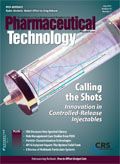Formulation Development Forum: Controlled Agglomeration for Poorly Soluble Drugs
Pharmaceutical manufacturers look to various solutions to resolve the challenge of poorly soluble drugs
Improving the solubility of poorly soluble drugs is an ongoing challenge. Dispersing a poorly soluble compound in a polymeric matrix to improve solubility and therefore bioavailability is one strategy. To produce the solid solutions or solid dispersions, various methods can be used, such as hot-melt extrusion, spray-drying, melt congelation, and nanocrystal technology (1). Veloxis Pharmaceuticals (formerly called LifeCycle Pharma), a technology spinoff from the Danish pharmaceutical company H. Lundbeck, uses a proprietary process, MeltDose, based on controlled agglomeration, to address the problem of poorly soluble drugs.
"Several technologies have been launched to deal with poorly soluble drugs," explains Peter Nielsen, executive vice-president of pharmaceutical development and CMC at Veloxis Pharmaceuticals. "Some technologies manipulate the particle size of the active pharmaceutical ingredient (API), and others influence dissolution rate. We see MeltDose as a technology that achieves all these improvements within the same technology."
Nielsen explains the company's approach. A low water-soluble drug substance is dissolved in a vehicle system that is optimized for each drug substance. The drug substance is spray-dried on an inert particulate carrier using fluid-bed equipment and solidified when disposed on the carrier. The carrier captures the active drug in a nanocrystalline or microcrystalline state or as an amorphous solid dispersion. This step is followed by agglomeration that is controlled by optimizing temperature and feed rate to produce the granules, which are directly compressed into tablets. Once in tablet form, the dissolution profile and particle size remain stable.
The selection of the vehicle to match the physiochemical properties of the API is an important consideration in the process. "In some formulations, the API will be present as an amorphous solid dispersion, such as in hot-melt extrusion and spray drying, but in other formulations, the API will be present as crystals in nanometer or micrometer size, resembling nanoproducts more," says Nielsen.
MeltDose, the proprietary process that Veloxis Pharmaceuticals has developed, centers on the controlled agglomeration process. "The controlled agglomeration process has some similarities to fluid-bed granulation," says Nielsen. Controlled agglomeration involves placing solid carrier particles in a conventional fluid bed, unto which a liquefied vehicle containing the API is sprayed. When the liquid vehicle is cooled down on the carrier, it agglomerates and forms granules. The controlled agglomeration process is water-free, and in contrast to conventional fluid-bed granulation, uses liquefied (i.e., melted) polymers as the polymeric vehicle. The polymeric vehicle is melted in a specially designed heated melt unit that controls temperature and pressure of the melted vehicle, which passes from the melt unit to a specially designed spray nozzle in the fluid bed, say Nielsen. The produced granules are compressed to tablets using conventional tablet presses.
The polymer vehicles used in the MeltDose process can include a range of hydrophilic and lipophilic materials and are selected for their solubility-enhancing properties and compatibility with subsequent processing steps. Examples of vehicle systems are solid or semisolid polymers with a melting point between 40 and 80 °C, such as polyethylene glycol 6000, poloxamers, and various types of gelucires. The resulting granule size varies with the choice of excipients and lies typically in the range of 200 to 500 μm, says Nielsen.
The vehicle temperature, the spray rate, the atomizing air volume, and product temperature all are important process parameters to consider during the controlled agglomeration step. Also, the addition of different surfactants can result in different sizes of API crystals in the granule (2).
Fenofibrate, a lipid-regulating agent to control cholesterol and marketed as Fenoglide in the United States by Shore Therapeutics, was the first product approved in the US using the MeltDose technology. Fenofibrate was initially approved by FDA in 1993 and later developed by Veloxis Pharmaceuticals using the MeltDose process in the formulation. Veloxis Pharmaceuticals received FDA approval for Fenoglide to treat hyperlipidemia and mixed dyslipidemia and hypertriglyceridemia in 2007. Sciele Pharma commercialized the product in the US and was subsequently acquired by Shionogi in 2008. In 2010, Shionogi Pharma terminated its Fenoglide North American commercialization agreement with Veloxis Pharmaceuticals, transferring commercial rights to Shore Therapeutics.
Veloxis Pharmaceuticals is working on other formulations that use the MeltDose process. The company has developed a once-daily modified-release formulation of tacrolimus, a poorly soluble compound with a water solubility of 4–12 μg/m, and the same API as in Astellas's Prograf, an immunosuppression drug used in kidney and liver transplants. Veloxis Pharmaceuticals has developed an amorphous solid-dispersion formulation of tacrolimus. The API was dissolved in a melted vehicle at elevated temperature. The solution was sprayed onto an inert carrier in a fluid bed. The resulting granulate was blended with a disintegrant and lubricant and compressed into tablets. The modified-release tablet formulation using the MeltDose technology was developed and tested in humans and is currently in late Phase III testing for the prevention of organ rejection with kidney transplants. Veloxis Pharmaceuticals expects to file for regulatory approval for the product, LCP-Tacro, in the US and European Union in the first quarter of 2013.
Editor's note: LifeCycle Pharma changed its name to Veloxis Pharmaceuticals, effective July 7, 2011, and the name used in this article was subsequently updated.
Sources
1. P. Van Arnum, Pharm. Technol. 32 (7), 96–98 (2007).
2. J.Q. Thomassen and P. Holm, "Controlling Fenofibrate Crystal Size in a Solid Dispersion Using MeltDose," presented at the Nanomedicine and Drug Delivery Symposium, Toronto, Nov. 2008.

Drug Solutions Podcast: A Closer Look at mRNA in Oncology and Vaccines
April 30th 2024In this episode fo the Drug Solutions Podcast, etherna’s vice-president of Technology and Innovation, Stefaan De Koker, discusses the merits and challenges of using mRNA as the foundation for therapeutics in oncology as well as for vaccines.